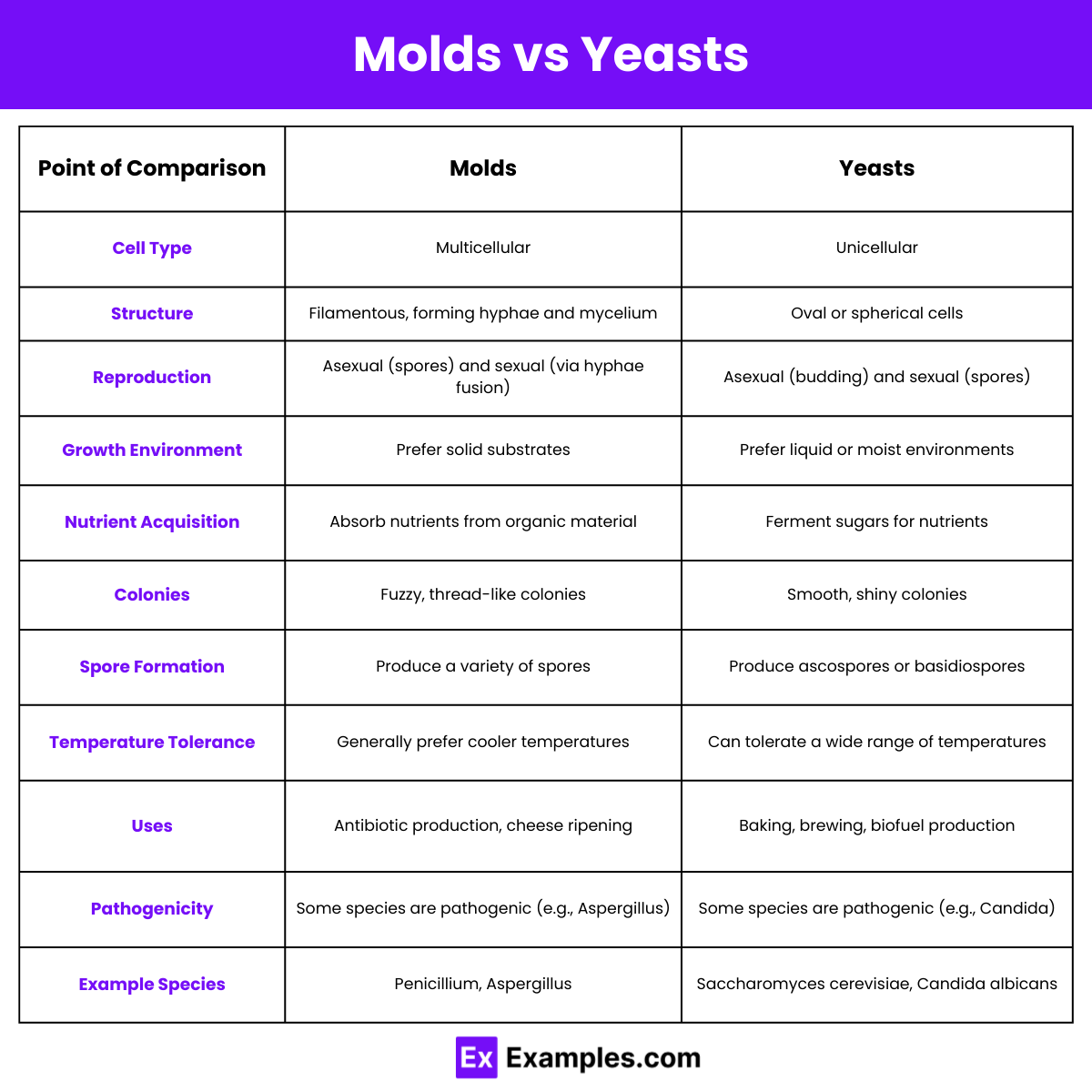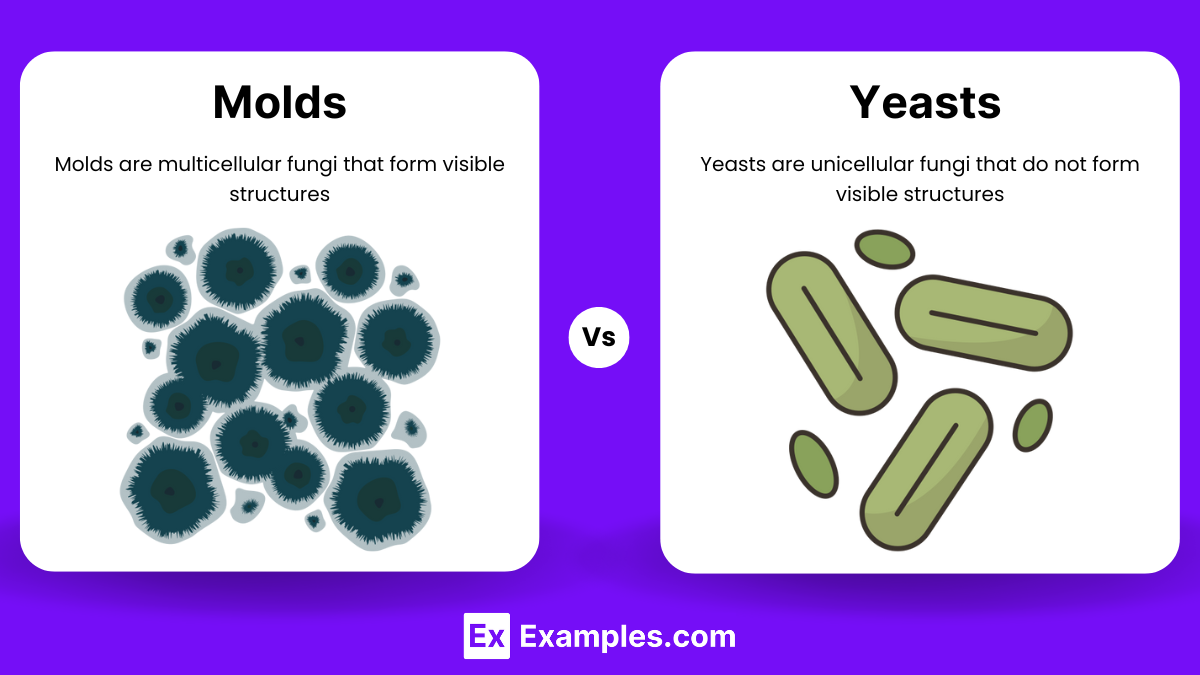Molds vs Yeasts – Differences Explained with Examples & Characteristics
Molds and yeasts play crucial roles in our world, impacting everything from food production to medicine. Understanding the differences between these two types of fungi can reveal fascinating insights into their unique characteristics and functions. Whether you’re a student, educator, or just curious, learning about molds and yeasts will deepen your appreciation for these microscopic powerhouses. Let’s compare molds and yeasts to see what sets them apart and how they contribute to our daily lives.
What are Molds?
Molds are a type of fungi that thrive in diverse environments, often found in damp and warm areas. They consist of multicellular filaments called hyphae, which form a network known as mycelium. This structure allows molds to grow rapidly and spread across surfaces. Molds reproduce through the production of spores, which are lightweight and can be easily dispersed by air, water, or living organisms.
Characteristics of Molds
- Structure: Molds are composed of long, thread-like structures called hyphae. These hyphae branch out to form a dense network known as mycelium.
- Color: Molds can appear in a variety of colors, including black, green, white, and orange. The color often depends on the type of mold and the substance it grows on.
- Reproduction: Molds reproduce asexually through spores. These spores are produced in large quantities and can survive harsh conditions, making molds highly resilient.
Types of Molds
- Aspergillus: Commonly found in soil and decaying vegetation. Some species are used in industrial processes, while others can cause allergic reactions.
- Penicillium: Known for its role in producing the antibiotic penicillin. It also plays a crucial role in the food industry, particularly in cheese production.
- Rhizopus: Often found on bread and other starchy foods. Some species can cause infections in humans, especially in immunocompromised individuals.
Importance of Molds
- Decomposition: Molds break down organic matter, recycling nutrients back into the environment.
- Medicine: Certain molds produce antibiotics, such as penicillin, which revolutionized modern medicine.
- Food Production: Molds are essential in producing foods like cheese and soy sauce. They also contribute to the fermentation process in certain beverages.
Health Impacts
- Allergic Reactions: Exposure to mold spores can trigger allergies and respiratory issues in sensitive individuals.
- Toxins: Some molds produce mycotoxins, which can be harmful if ingested or inhaled. These toxins can contaminate food supplies and pose serious health risks.
- Infections: Certain mold species can cause infections, particularly in people with weakened immune systems.
Control and Prevention
- Moisture Control: Keeping indoor environments dry and well-ventilated helps prevent mold growth.
- Cleaning: Regularly cleaning and disinfecting surfaces can reduce the presence of mold spores.
- Proper Storage: Storing food in dry, cool conditions helps prevent mold contamination.
Examples of Molds
- Black Mold (Stachybotrys chartarum): Often found in buildings with water damage. It is notorious for producing mycotoxins that can cause severe respiratory problems.
- Green Mold (Penicillium chrysogenum): Found on food like bread and citrus fruits. This mold produces penicillin, a groundbreaking antibiotic used to treat bacterial infections.
- Blue Mold (Penicillium roqueforti): Used in the production of blue cheeses such as Roquefort, Stilton, and Gorgonzola. This mold gives these cheeses their distinctive flavor and appearance.
- White Mold (Mucor): Commonly found on decaying fruits and vegetables. While generally harmless, it can cause issues in immunocompromised individuals.
What are Yeasts?
Yeasts are single-celled fungi that play a significant role in various biological and industrial processes. Unlike molds, which are multicellular, yeasts consist of individual cells that typically reproduce by budding. These microorganisms are found in diverse habitats, including soil, plant surfaces, and the human body. Yeasts are particularly known for their ability to ferment sugars, making them essential in baking, brewing, and winemaking.
Characteristics of Yeasts
- Structure: Yeasts are unicellular organisms with a round or oval shape. They lack the hyphal structure of molds and usually reproduce by a process called budding.
- Size: Yeasts are microscopic, with cell sizes ranging from 3 to 40 micrometers in diameter, depending on the species.
- Reproduction: Yeasts primarily reproduce asexually through budding, where a new cell forms and detaches from the parent cell. Some yeasts can also reproduce sexually through spore formation.
Types of Yeasts
- Saccharomyces cerevisiae: Known as baker’s or brewer’s yeast, it is widely used in baking, brewing, and winemaking. It ferments sugars to produce carbon dioxide and alcohol.
- Candida: Includes species that are part of the normal human flora but can cause infections in immunocompromised individuals. Candida albicans is a common pathogen responsible for yeast infections.
- Cryptococcus: Includes species that can cause serious infections, such as Cryptococcus neoformans, which can lead to meningitis in immunocompromised individuals.
Importance of Yeasts
- Fermentation: Yeasts convert sugars into alcohol and carbon dioxide through fermentation. This process is fundamental in baking, brewing, and winemaking.
- Biotechnology: Yeasts are used in genetic research and biotechnology for producing proteins, enzymes, and pharmaceuticals.
- Nutrition: Yeasts are rich in vitamins and proteins, making them valuable as dietary supplements.
Health Impacts
- Infections: Some yeast species, like Candida albicans, can cause infections in humans, particularly in those with weakened immune systems.
- Allergies: Exposure to certain yeasts can trigger allergic reactions in sensitive individuals.
- Toxin Production: Some yeasts can produce harmful byproducts, although this is less common compared to molds.
Control and Prevention
- Hygiene: Maintaining good personal hygiene can help prevent yeast infections, especially in areas prone to moisture.
- Dietary Management: Limiting the intake of sugary foods can help reduce the risk of yeast overgrowth in the body.
- Medical Treatment: Antifungal medications can effectively treat yeast infections. Probiotics may also help maintain a healthy balance of microorganisms in the body.
Examples of Yeasts
- Baker’s Yeast (Saccharomyces cerevisiae): Essential in baking bread, this yeast ferments sugars to produce carbon dioxide, which makes dough rise.
- Brewer’s Yeast (Saccharomyces pastorianus): Used in brewing beer, it ferments maltose to produce alcohol and carbon dioxide, contributing to beer’s flavor and carbonation.
- Wine Yeast (Saccharomyces cerevisiae): Plays a crucial role in winemaking by fermenting the sugars in grape juice to produce wine.
- Candida albicans: Part of the normal flora in the human body but can cause infections like thrush and vaginal yeast infections under certain conditions.
- Saccharomyces bayanus: Often used in sparkling wine and cider production due to its ability to ferment at lower temperatures and tolerate high alcohol concentrations.
- Cryptococcus neoformans: A pathogenic yeast that can cause serious infections, especially in immunocompromised individuals, leading to conditions such as cryptococcal meningitis.
Differences between Molds and Yeasts

| Feature | Molds | Yeasts |
|---|---|---|
| Cell Structure | Multicellular | Unicellular |
| Appearance | Fuzzy, filamentous | Smooth, round or oval |
| Hyphae | Present, forming mycelium | Absent |
| Reproduction | Asexual (spores), sexual (zygospores) | Asexual (budding, fission), sexual (ascospores) |
| Habitat | Soil, decaying matter, moist environments | Sugar-rich environments, fruit, and plant leaves |
| Growth Form | Filamentous, forming networks | Individual cells or pseudohyphae |
| Nutritional Mode | Saprophytic, decomposing organic matter | Saprophytic, some are pathogenic |
| Color | Various (green, black, white, etc.) | Typically white, but can be other colors |
| Oxygen Requirement | Aerobic | Facultative anaerobes |
| Temperature Tolerance | Wide range, generally prefers cooler environments | Mesophilic, prefers warmer environments |
| Industrial Use | Production of antibiotics, enzymes | Fermentation (bread, beer, wine) |
| Pathogenicity | Some species cause allergies, infections | Some species can cause infections (e.g., Candida) |
| Spores | Produces numerous spores for reproduction | Does not produce spores, reproduces by budding |
| Cell Wall Composition | Chitin and glucans | Mainly glucans and mannans |
| Growth Rate | Generally slower growth rate | Generally faster growth rate |
Similarities Between Molds and Yeasts
1. Kingdom Fungi
- Classification: Both molds and yeasts are classified under the kingdom Fungi, indicating they share common ancestry and fundamental biological traits.
2. Eukaryotic Organisms
- Cellular Structure: Molds and yeasts are eukaryotic, meaning their cells contain a true nucleus and other membrane-bound organelles, unlike prokaryotic bacteria.
3. Heterotrophic Nutrition
- Nutritional Mode: Both molds and yeasts are heterotrophs, relying on organic substances for nutrition. They secrete enzymes to break down complex organic matter into simpler compounds, which they absorb and utilize for growth and energy.
4. Reproduction
- Asexual Reproduction: Both molds and yeasts can reproduce asexually. Yeasts primarily reproduce by budding or fission, while molds reproduce via spores such as conidia or sporangiospores.
- Sexual Reproduction: Under certain conditions, both can also engage in sexual reproduction, producing spores through processes like meiosis.
5. Cell Walls
- Composition: The cell walls of both molds and yeasts are composed of chitin and glucans, which provide structural support and protection.
6. Growth Conditions
- Environment: Both molds and yeasts thrive in moist, warm environments and can often be found in similar habitats such as soil, decaying matter, and in association with plants and animals.
- pH Tolerance: They can grow in a variety of pH conditions, although most prefer slightly acidic environments.
7. Metabolic Flexibility
- Fermentation: Yeasts are well-known for their role in fermentation, producing alcohol and carbon dioxide. Some molds also have the capability to ferment certain sugars under anaerobic conditions.
- Enzyme Production: Both produce a variety of enzymes that enable them to decompose organic material, contributing to nutrient cycling in ecosystems.
8. Pathogenic Potential
- Disease-Causing: Both molds and yeasts can be pathogenic to humans, animals, and plants. Common examples include Candida infections caused by yeast and respiratory illnesses caused by mold species like Aspergillus.
9. Industrial and Commercial Use
- Biotechnology: Both are used in industrial processes. Yeasts are essential in baking, brewing, and biotechnology, while molds are used in the production of antibiotics, cheeses, and other fermented products.
10. Ecological Roles
- Decomposers: Both play crucial roles as decomposers in ecosystems, breaking down dead organic matter and recycling nutrients.
What are molds and yeasts?
Molds and yeasts are fungi. Molds are multicellular, forming hyphae and spores, while yeasts are unicellular and reproduce by budding.
How do molds and yeasts reproduce?
Molds reproduce through spores, while yeasts reproduce primarily by budding, a form of asexual reproduction.
Where can molds and yeasts be found?
Molds grow in damp, warm environments on organic matter. Yeasts are commonly found on fruits, in soil, and in fermented foods.
Are molds and yeasts harmful?
Some molds produce toxins harmful to humans, while others are harmless or beneficial. Yeasts are generally safe, with some causing infections in immunocompromised individuals.
What is the role of molds in food spoilage?
Molds decompose organic matter, leading to food spoilage. They produce enzymes that break down food substances.
How are yeasts used in food production?
Yeasts are crucial in baking, brewing, and winemaking, converting sugars into carbon dioxide and alcohol through fermentation.
Can molds and yeasts be beneficial?
Yes, molds are used in antibiotic production (e.g., penicillin) and food ripening. Yeasts are essential in fermentation and probiotics.
What are common examples of molds and yeasts?
Common molds include Penicillium and Aspergillus. Common yeasts include Saccharomyces cerevisiae and Candida.
How can mold growth be prevented?
Prevent mold growth by controlling humidity, fixing leaks, and ensuring proper ventilation. Store food properly and dispose of spoiled items promptly.
How are yeast infections treated?
Yeast infections are treated with antifungal medications, including topical creams, oral pills, and suppositories, depending on the infection’s location and severity.



